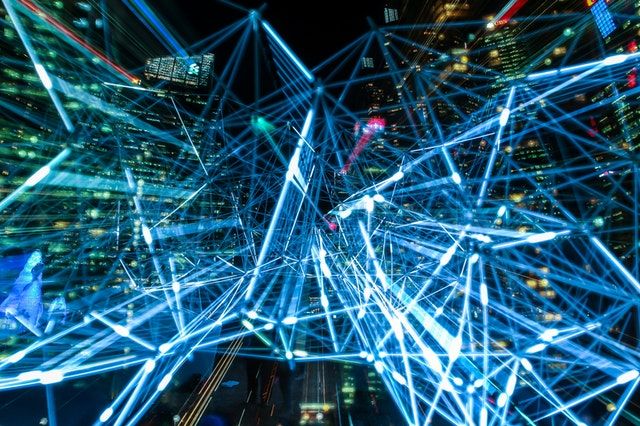Scope of AI in Construction Industry
Artificial intelligence (AI) can help the construction sector expand faster by eliminating possible roadblocks in large-scale projects, from the tendering stage to project completion. The most significant technologies affecting this category are AI-powered automation and robotics.

Construction is considered one of the most ancient professions as human beings have been constructing shelters for millennia. With time, as the technology evolved, the construction activities including the techniques, designs, and implementation of projects also emerged. However, the global construction industry is still far behind in growth when compared to other industries.
Challenges: Why Construction Industry is facing a Growth Lag?
The construction industry is facing great challenges including safety apprehensions, schedule and cost overruns, etc. Based on these disruptions, in the last decade, the worldwide construction industry has observed its slowest growth pace when compared to other sectors as its growth rate dropped to 2.6% according to the GlobalData report. Moreover, a report by McKinsey reveals that the construction sector has just gone through 1% labor-productivity growth through the last two decades. Comparatively, other sectors like retail and manufacturing are growing at an exponential rate. The reason behind this growth lag in the construction industry is the lack of investment in digitization to overcome the challenges hindering the growth in this sector. Though technology is being used, the construction industry is far behind and sluggish in adopting modern technologies as compared to other sectors that have reinvented themselves through automation and digitization to cope up with the digital age.
In this article, we will discuss how AI could be helpful at various stages of the project life cycle and how it can accelerate the growth of the construction industry by overcoming potential barriers.
AI potential in Construction Industry
Today, the construction industry is a budding and unified ecosystem of software and hardware solutions. With increased disruption in the ecosystem, the focus on incorporating the most revolutionary technologies to find out the solutions is growing. AI is evolving and transforming the world at a rapid speed offering unparalleled opportunities in virtually every region including Construction Industry. No doubt, technology has been employed in this industry for decades to make this job more efficient and safer, but AI has the potential to make construction activities more structured and organized. When dealing with large-scale projects, the project managers might find difficulty in carrying out certain complicated tasks using conventional methods or technology. Here AI comes in with its huge potential. The diverse nature of AI makes it more appealing for a large-scale project to streamline different processes involved in the completion of a construction project ranging from the initial stage of the tender process to the last stage of project completion. AI-powered automation and Robotics are the most prominent technologies influencing this segment considerably. AI can accelerate productivity in the construction industry by 60%. It can add a value worth $1.6 trillion that is more or less 2% of the worldwide economy. A few companies have realized the potential of AI at the operational, commercial, and environmental levels and started adopting this technology to overcome their growth lag. From adjusting work schedules and ensuring worksite safety to monitoring construction activities, AI is undoubtedly proving its worth in this sector.

How AI can help overcome Challenges faced by Construction Industry?
AI is an extremely useful tool at every stage of the construction project completion cycle. Let's discuss how AI is supporting manage construction projects by overcoming extensive challenges.
AI supporting the initial stage of the project
At the initial stage of a project's lifecycle, several processes like bidding, documentation, planning, and designing are the most crucial to ensure the successful completion of a construction project. Moreover, time and cost are the key metrics to measure the success of the project management team. The most crucial challenge for the construction industry is to control the cost of construction projects and to inhibit cost overruns. Studies reveal that most of the projects that the construction industry delivers are more costly than projected. Therefore, the initial estimate of overall cost must be as precised as possible to eliminate the risk of cost overruns. Here AI plays a vital role in supporting this preliminary phase of construction to safeguard success at the later stage as well.
AI-based Bidding and Tendering
Before starting a construction project, the first step is to achieve success in the initial tender process. Here come AI algorithms with their potential to boost the success rate of the construction company. These algorithms are used by the construction team to project the probability of a go/no go scenario, improve margins and ensure project value from the very first stages. AI is used in evaluating earlier project bids to find out what elements led to the success and what caused failure in winning the contract. Dodge Data and Analytics is one of the firms providing AI tools like NLP to construction professionals. These AI tools help the construction firm to avoid failures by analyzing previous data and projects and learn from this analysis rather than start scratching each time.

AI-powered OCR (Optical Character Recognition) for documentation
After bidding and tendering, the next step is documentation. Here again, AI-powered OCR is of great use. OCR is the conversion of printed or handwritten text images into machine-encrypted text. Instead of the conventional way of typing a document manually, OCR converts the images into data that is searchable and editable. Ultimately, the editing and search for documents’ databases become easier while reducing time and cost. Egnyte is an application using OCR to scan, name, number, and link the related sheets to reduce time and cost. It also makes it easy to group several projects and get archived projects, hence making the information accessible at the fingertips.
AI-driven Generative Design to generate an improved design of the building
While planning and designing the construction of a project, different teams including engineering, electrical, and mechanical are involved along with architecture. All these professionals are planning their activities in a way or the other to accomplish the project. There is a great chance that the different models prepared by these different teams might clash with each other. Preventing such clashes is a great challenge in construction.
AI-driven generative design tool helps in the designing process. This tool emulates the evolutionary approach of nature for designing. First of all, the designer feeds the specific design goals into the system like Autodesk. A software employing ML algorithm analyzes all kinds of solution variations and generates alternatives for designs. The design software then explores numerous variations of possible solutions, optimizes the constraints in each model, and after learning from several duplications, it comes up with the best model.
AI-based Data Analytics to prevent Cost Overruns
Before starting a construction project, the cost of the resources throughout the project lifecycle is roughly estimated and this estimation requires expertise. For the past several decades, these cost estimates have been mostly different than the actual cost calculated at the end of the project. Construction budget getting overrun is problematic for any industry. Several mega projects despite hiring the finest project teams have to face cost overruns. Avoiding cost overrun is a great challenge in construction. According to the experts, these inaccurate cost estimates are on account of several technical, political, and economic factors. Thanks to AI: today these cost overruns can be avoided through data analytics that assist organizations to generate deep insights from historical cost data. AI-driven predictive tools deliver a more accurate cost estimate and help in controlling the cost and time of the project. AI-powered ANNs analyze the size of the project, and the type of contract along with the competency of the project managers to reduce cost overruns.

ML-based Pattern Identification to develop Contingency Plans
ML is used to find patterns in a construction project along with common trends. Based on these patterns, the construction management team analyzes the "what-if" scenario and comes up with contingency plans. AI helps in extrapolating that what could be the alarming results in case of delayed permit or any incident. This analysis is performed in multiple scenarios. Hence, using AI, the construction manager can ensure contingency plans to cope up with unforeseen situations.
AI supporting the Execution stage of the project
Successful planning of the initial phase of a construction project paves the way towards the successful execution of the project. Let's have a look at how AI helps in executing a construction project:
AI-based scheduling
Whether it's about constructing a home, an office, or any other project, unfortunately, you must have observed some problem with the process like over-scheduling. Construction managers can employ AI to automate most of the routine and tedious but significant tasks to keep their operations running in an efficient and accelerated way. When it’s about scheduling, AI can avoid expensive delays on worksites as well as amongst stakeholders. AI is assisting the construction team in scheduling tasks in a way that decreases the chances of conflicts, delays, or any other related issue.
AI-based Predictive Analytics to mitigate the risk of Machinery and Human Safety
Modern machines used in construction are equipped with different AI-powered sensors to intelligently monitor overall operations on construction sites. These sensors observe various parameters during construction including engine condition, temperature, and features of material application. These AI tools evaluate real-time data and predict upcoming problems including delays, or any type of failures that may occur. This sort of predictive maintenance results in avoiding downtime and delays.
Construction involves a serious level of safety hazards as well. The potential hazards range from dangerous structures to transporting heavy equipment. These hazards pose safety concerns for humans. Cameras with AI-powered sensors observe what is going on 24/7 and hence continuously monitor the construction operations. AI-based facial and object recognition technology can easily identify the abnormal behavior of employees or any operation and immediately issues alerts of the potential hazards for the construction team to take a preventive step. This predictive analytics reduces liability, increases efficiency, and saves human lives.
Moreover, AI-powered surveillance systems ensure additional security by continuously observing the construction site for any suspicious activity. The construction site with expensive equipment can be a hotbed to attract thieves. AI-based tools can monitor supplies and equipment to send alerts in case of any suspicious activity.

AI-based Computer Vision and ML to manage the onsite Inspection Process
If the project is small, like constructing a house, one can easily observe the worksite to find out what is missing and can manage the problem. However, in the case of huge and complex projects, planning is a hard task as it is quite difficult to find out what is missing. Visual inspection is the traditional way to understand if the planned schedules are going to meet or not. AI has made this task easy, more accurate, and efficient through its computer vision and ML techniques. AI-driven computer vision and sensors easily track the materials' and workers' movements across the construction site and automatically flag in case material or equipment are placed at the wrong place. Moreover, AI-powered drones having the capability to take overhead images, deliver a detailed view of the construction site throughout the project. Many companies like ABJ Drones, Propeller, and DJI are selling drones to inspect the worksite automatically. Komatsu is also using drones and cameras to furnish the construction team with the real-time and précised insight of the worksite to measure and improve the productivity of the project along with the quality of the building. A Komatsu drone can complete a survey of 20,000m2 worksite in just 30 minutes that could take 3 days if conducted conventionally.
A startup named Buildots endeavors to accelerate and enhance the precision of the inspection process and hence boost process management. A light and wearable camera connected to the safety helmets of the construction team collects several images to analyze later on. These images are analyzed through AI. The AI vision module inspects walls, lighting equipment, windows, and several other objects in the pictures. This information about the worksite obtained through inspection and analyzed through AI is then compared with planned CADs. Here, again AI comes up to match the images with the software model. AI enables the architects to analyze the precision and progress of the project while curtailing time and cost overruns.
AI-powered Autonomous Vehicles invading the construction areas
Autonomous vehicles such as those made by Volvo can transport construction tools and building materials from one place to another. Built Robotics, a San Francisco-based startup enables heavy construction machinery including dozers, and diggers to function independently without any human intervention.
AI-driven Robotics to help execution of the project
Nowadays, the construction industry has a great array of robots with great potential. AI-driven robots can be a great support to execute a construction project. Robots are already being used in performing heavy tasks like bricklaying and concrete pouring etc. These autonomous tools are not just reducing the labor costs but are also accelerating the construction process to ensure project completion on or before time without any delays. According to a 2020 report by IDC, in the construction industry, the investment in robots will grow and reach $241.4 billion by 2023.
California-based Doxel creates a mobile robot to calculate the progress of the project. Another robot called Spot made by Boston Dynamics is a four-legged robot used by construction teams. A kitchen stove-sized, four-wheeled AI-powered robot by Arevalo working at Canvas can perform the task of dry-walling with the same artistry and fineness as a trained human worker. This robot is equipped with laser scanners, and sensors along with a robotic arm to navigate construction sites. It uses lidar to scan the unfinished walls, and then it applies the layer of drywall after smoothing the wall surface.

AI to enhance environmental sustainability
According to “the Global Status Report”, in 2017, 11% of CO2 emitted worldwide was contributed by the construction industry. This percentage when added with 26% of CO2 emitted by buildings themselves result in 37% global emissions of CO2 contributed by the construction industry and buildings together.
Comfy, an app by Building Robotics gathers data from BMS (Business Management System) and optimizes temperature in the building based on user’s demand for hot or cool air. With time, this AI-powered app recognizes the preferences of the building residents and automatically optimizes temperature keeping in view the trends. It results in saving the cost and enhancing energy efficiency while reducing carbon emission.
Carbon Calculators
Elliott Wood along with the collaboration of (IStructE) has developed a carbon calculator. This calculator is applicable to project of any size. By entering specifications and quantities of the materials, it can find out the carbon footprint of a column within few minutes and that of a simple structure within thirty minutes. Then it determines the carbon hotspots in the project and finds alternative approaches to reduce the carbon footprint. The carbon calculator forecasts the project cost of embodied carbon by using BIM and historical data from previous projects. UWE Bristol and Winvoc are among the companies that employ an AI system (ASPEC) to forecast embodied carbon in construction projects. This AI system ASPEC analyzes a hypothetical design and finds out what sort of materials to be used to reduce the carbon footprint of the project. This would eventually result in reduced material wastage, and of course environmental impact while accelerating the project completion. Using this calculator has resulted in saving up to 14% carbon through selecting better environmentally friendly designs. Besides reducing carbon emissions, it has also decreased fuel costs.

Summary
AI is a revolutionary technology that can propel our construction industry to an era of wonders. The complexity of the construction industry involving several manual tasks makes AI the most compelling technology hosting benefits of improving productivity, accelerating designing, ensuring human safety and environmental sustainability, and reducing time and cost overruns. Augmented by AI advancements, machine generation is automating the construction industry. Cheap laser sensors and robotic arms, computer vision and open-source navigation software have consequently increased automation in the construction industry. Predictive models of AI use historical data to envisage a more accurate timeline for projects. Conclusively, AI in the construction industry is extremely helpful in optimizing tools, scheduling, avoiding delays, safety risks, and reducing overall cost.
Keeping in view the incredible results of AI, it’s not surprising that AI is sooner or later going to dominate the construction industry like many other sectors.



